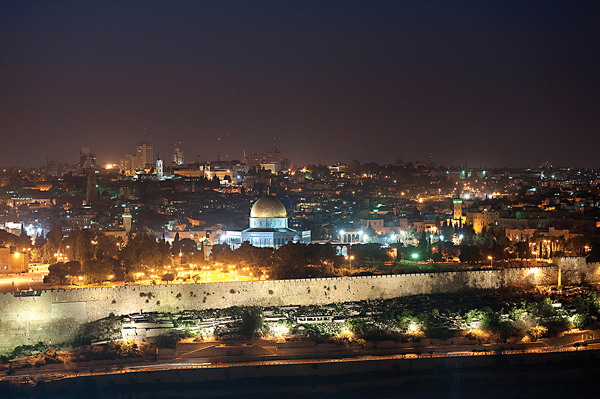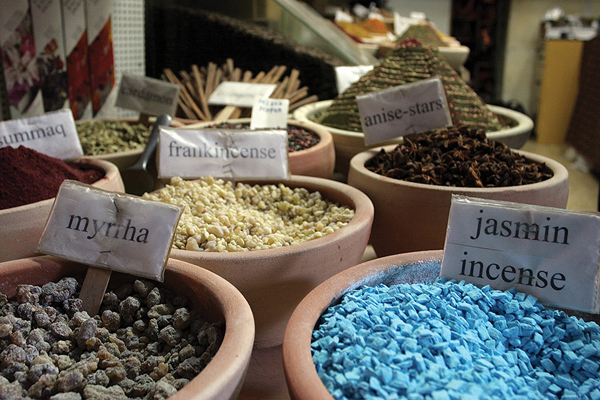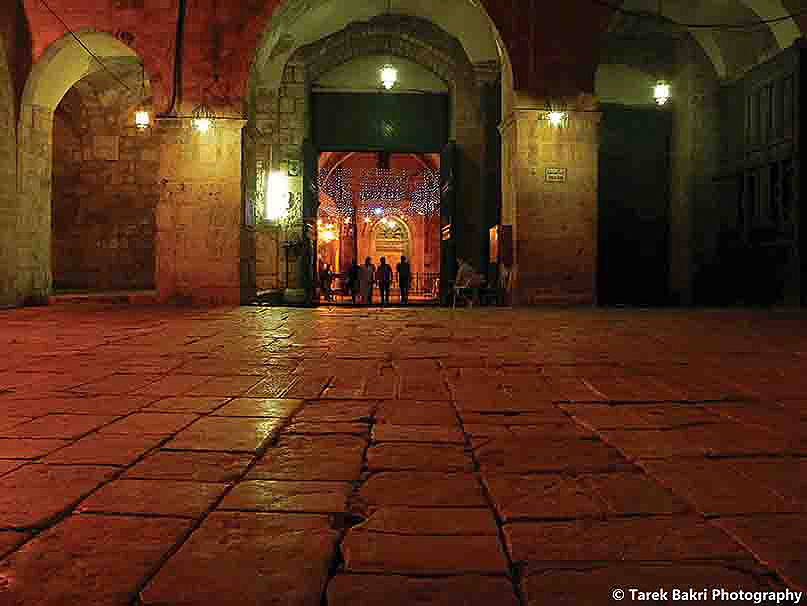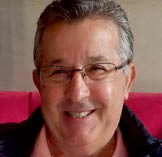
Every city has its unique character, tempo, and feel with which it becomes synonymous: the exuberant dynamism of Paris; the languor of Rome, the eternal city; and the Big Apple, New York. In Jerusalem the sacred exudes an overwhelming sense of spiritual serenity and transcendence that is riveting. Jerusalem is beautiful; as we look at it, we can never imagine being dissatisfied with it, aesthetically. It is sacred, it is historic, and it is magical.
Legend, myth, and ritual meet in Jerusalem, for it has been forever the scene of the manifestation of divine intervention in human history. Jesus spent his last days on earth in the streets of the Holy City, and Prophet Mohammad connected with Allah in Jerusalem during the Night Journey. The legends of King Solomon, the hoopoe, and the charmed encounter with the Queen of Sheba took place here; the human drama of God and man, of love and hate, of good and evil, the lore of which we learn in the Judeo-Christian and Muslim holy scriptures and traditions.
An overpowering sense of sacred presence permeates the precincts and comingles with the architectural edifices of the Noble Sanctuary, the Church of the Holy Sepulcher, and Al-Buraq to endow the Holy City with a transcendent quality. The heart of Jerusalem beats in Al-Waad Street. On Fridays, the street becomes crowded with peddlers, beggars, and people on their way to pray. “From God’s bounty give me.” The litanies of the beggars pleading for charity resonate with the staccato advertising calls from the boisterous shopkeepers and peddlers, each pushing his merchandise. Bells from the belfries and calls to prayer from the mosques mix with music from the cafés and shops, and that of the haggling of shoppers and salesmen in a rapturous cacophony. Through the smoke that rises from the grill of the kebab vendors, Jerusalem exudes an unmistakably oriental air. The vendors, the beggars, and the shoppers become figures within a tableau that recreates the magical splendor of Cairo, Baghdad, and Istanbul as depicted in One Thousand and One Nights.
Jerusalem flashes infinite pictures. Myriad moss-clad domes, like prehistoric turtles, perch on winding alleys, and weathered building fronts cascade between the majestic golden Dome of the Rock and the lead dome of the rotunda in the church of the Holy Sepulcher.

In former days the Cotton Market, the covered bazaar, would provide the most spectacular entrance to Al-Aqsa Mosque, now closed by the Israelis. The long, dark tunnel leads to a staircase in deep shadow. Standing on the dark landing, the gold of the Dome glistens in the bright sunlight. Climbing the dark steps, one is overwhelmed by the glow outside. Slowly the eyes adjust to the light that shines above one’s head. Through the small open entrance in the giant, fresh leaf-green painted gate, the deep-green pine tree, the silver-green palm tree, and the blue ceramics covering the walls of the Dome of the Rock comingle in a sacred symphony of blue, green, turquoise, ochre, and gold.
The energy of Jerusalem alleviates the sense of existential loneliness, heals, and exhilarates. On another level, when I take a walk and stroll downtown (al-balad), I am aware that I am opening myself up to the archetypal spiritual energy of the Holy City, which rises up and completely fills me, transforming my own energy, so that I at some point incarnate and actually become Jerusalem, overflowing my body boundaries and becoming one with the universal spirituality it exudes.
Colors, sounds, and smells combine to give the city its unique character. Each neighborhood has its own distinctive scent. One knows that one has reached Zalatimo Pastry Shop even before entering it by the smell of clarified butter and honey. The sweet aroma reaches one’s nose and from far away is easily distinguishable from the hundreds of smells that saturate the commercial thoroughfares.
The first scent that assails one upon entering Damascus Gate, immediately after walking down the stairways, is that of the toasted coffee from Izhiman’s Coffee Shop at the juncture of Al-Waad Street and Suq Khan al-Zeit. The aroma of freshly roasted and ground coffee dissolves into that of freshly baked bread and sweet, crunchy, warm round ka’ek and toasted sesame seeds that soon merges with the pungent aroma of pickles, olives, and cheese in Al-Hidmi Grocery.
Gradually the smell of pickles gives way to fragrant rosewater. Deep beyond Suq Khan al-Zeit, the Spice Market enthralls with Jerusalem’s bouquet of cardamom, coriander, cloves, cinnamon, cumin, fenugreek, nutmeg, pepper, saffron, turmeric… The lofty quarters of Jerusalem are redolent with incense. Scents of musk oils and perfumes from Muslim sanctuaries, and myrrh and frankincense from the Christian monasteries and churches rise from the city into a misty fragrant haze.
♦ You enter Damascus Gate as though you are entering an enchanted cave. You walk along a street knowing full well that underneath it runs another street, from another period, and you feel dizzy. The foundations of Jerusalem homes are deeply rooted in Palestinian history throughout the ages.
From the Mount of Olives, at sunrise, a lavender cloud hangs over Jerusalem. The rising sun quickly dissipates the deep purple morning mist into deep blue that by the early morning hours turns into cerulean blue. The same panoramic vista abounds with religious symbolism. In this image, sacrosanct to every Palestinian, the houses pile high, one on top of the other behind a great wall that surrounds the city. In the depiction Jerusalem is a still life; a stone sculpture of domes of various shapes and volumes on top of squares punctuated by minarets, belfries, crosses, and crescents. The golden Dome of the Rock dominates the picture. To its left, the lead dome of Al-Aqsa Mosque hides behind cypress trees. In the middle of the city rises the dome of the rotunda enshrining the Holy Sepulcher of Jesus.
The Church of the Holy Sepulcher is a complex building that hosts numerous churches. Roman Catholics, Armenians, and Greeks share rights of access and partition the space within and without – including the roof – with the Copts and the Syrians.

The Saturday of Light is the most joyful ceremony. On this occasion that commemorates Jesus’ resurrection, Christians of the Eastern churches crowd into the Holy Sepulcher. Each person stands within the boundaries of his or her own sect. People stand for hours waiting for the eruption of the Holy Fire through a small window in the tomb of Jesus. At noon, the electric lights are dimmed. The church soaks in shadows and a hushed silence hovers. The cavernous rotunda drowns with myrrh and frankincense. The bells begin to ring rapturous religious melodies. All of a sudden the light flashes in the darkness. In the wink of an eye the light moves from candle to candle throughout the church, and the pilgrims become a procession of light. The aroma of burning beeswax saturates the air. The walls of the church resonate with traditional Eastern liturgical chants, and the bells continue to pound. Young men, lifted on shoulders, pass the flame among the awestruck crowd. Amidst the ululation and singing, the Holy Fire, in candles and lanterns, floats overhead from hand to hand to be carried to the Eastern churches all over the earth. Holy Saturday is a Jerusalem symbol.
♦ Jerusalem has always been the center of strife. The rise and fall of various civilizations have left infinite traces. Their remains have been used as elements, absorbed and assimilated, in the cultural ethos of the nations that followed. The facades of the houses, palaces, theological colleges, mosques, monasteries, churches, temples, and zigzagging streets and alleys are silent witnesses to its central position as a crossroads of Judeo-Christian and Muslim spirituality.
As in a kaleidoscope, the Jerusalem images combine and recombine to form a repertoire of iconic images with seasonal, religious, and ethnic ritual character. Each of us carries a unique Jerusalem in his/her heart. Jerusalem floats as a vision of gold. Yellow ochre, cream, grey, pink, and red bounce off the meleke and mizzi stones and give the Holy City a magical luminescent painterly quality. Sunlight on the cream-colored limestone edifices gives them a golden-ochre hue. The light reflects off the facades of sumptuous Mamluk and Ottoman edifices, dissolves the spectrum of lustrous colors, and soaks Jerusalem labyrinthine alleys in a haze of translucent amber honey. Shades of pale blue lurk beneath the edges of the stairs, navy blue in the gaping tunnel-like doorways that becomes deep purple piling under the cavernous covered passageways. The glow of the daylight yields to night. By the time the muezzin calls for evening prayer the stones drown in soft grey-blue under a lapis lazuli sky. By night the domed roofs huddle together under mysterious deep-purple-blue to be dispelled by the golden-ochre light of sunrise.
Strange how one completely buzzes with creative energy while being the creative field, the afterglow resonates and then one must renew and re-engage with Jerusalem in order to become creative energy again. In Jerusalem timeless awareness requires time. Time requires timeless awareness.
The trials and tribulations of history: Al-Nakba, the 1967 defeat, and the impending danger of the Israeli takeover of Al-Aqsa Mosque have thrust Jerusalem into a vicious cycle of violence. Short of a miracle, Jerusalem like sand is rapidly slipping through our hands. The fear has been augmented by the Israeli violations of the status quo, and its effect on every Jerusalemite – both Christian and Muslim – is traumatic. We live in the memories of the past. Nostalgia, longing, and an unfathomable sense of loneliness envelop Jerusalem in a halo of huzon – sublime melancholy; a bittersweet refrain whose echo reverberates behind every step in Jerusalem. We stay steadfast. Reality is that of the heart.
» Dr. Ali Qleibo is an artist, author, and anthropologist. He has lectured at Al-Quds University and held a fellowship at Shalom Hartman Institute; he was a visiting professor at Tokyo University for Foreign Studies, Japan. As a specialist in Palestinian social history and through his work at the Jerusalem Research Center, he has developed the Palestinian Social and Muslim Tourism Itinerary. Dr. Qleibo has authored various books, including Surviving the Wall, Before the Mountains Disappear, and Jerusalem in the Heart. A renowned oil painter, he has held numerous art shows. He may be reached at aqleibo@yahoo.com.


